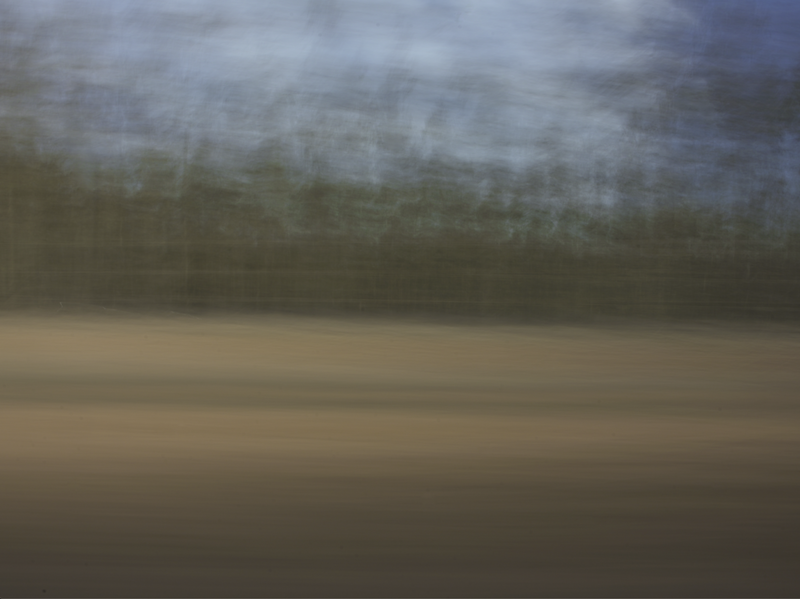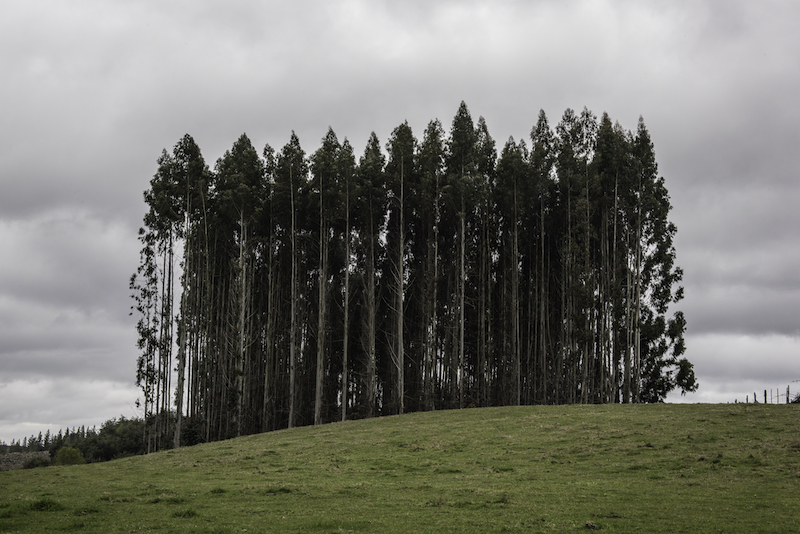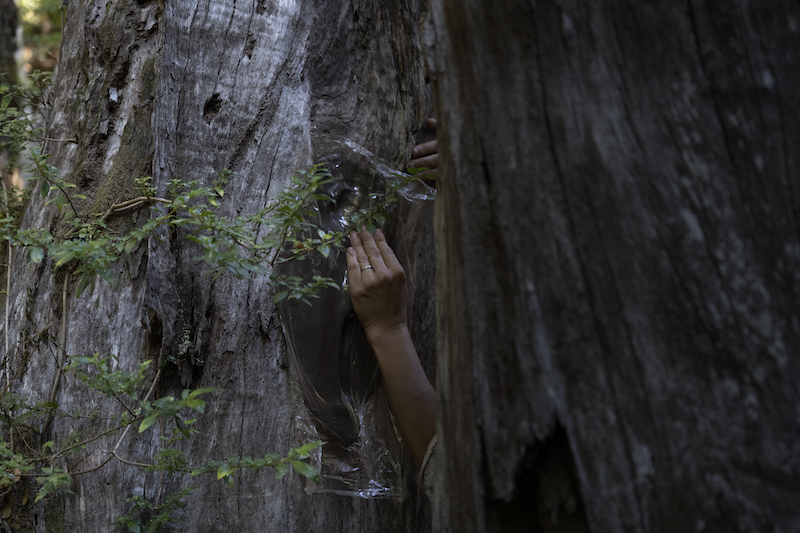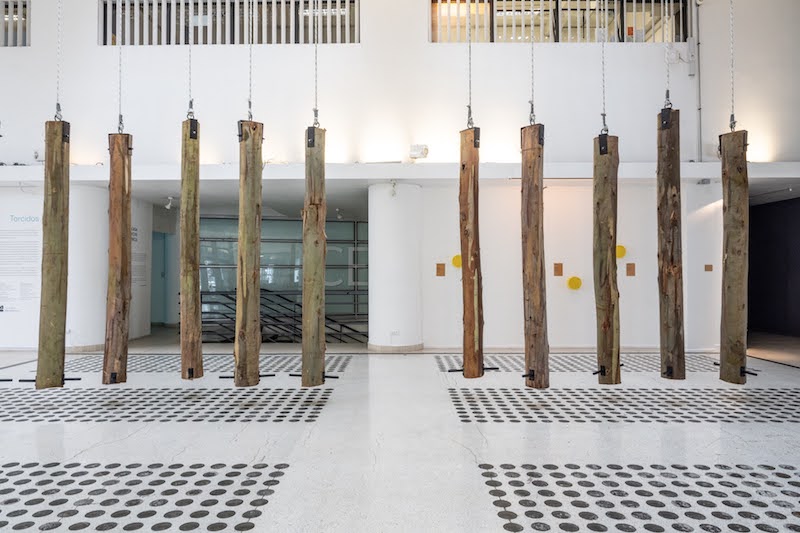by Juan José Santos Mateo // May 17, 2024
This article is part of our feature topic Habitat.
The view from the car window: a horizontal spot of blue above, green in the middle and brown below. It is always the same landscape. When the vision becomes repetitive, it disappears: speed homogenizes it until it becomes mere background. Only when the car slows down and stops can we see them. There they are. There they were. The trees.
Agencia de Borde (Rosario Montero, Paula Salas and Sebastián Melo) is a Chilean collective whose origins were marked by an initial impulse to exchange conversations across geographical boundaries, as Latin American migrants in the UK and the Netherlands. This anecdotal context expanded with the drive to frame their practice at the border of categories and disciplines. Today, their practice takes place at the crossroads of art and anthropology, researching the representation of the natural environment from both a political and sensory perspective. With their latest exhibitions ‘Bosques de Fuego’ (MSSA) and ‘Árboles Torcidos’ (Centex Valparaiso)—which both took place in Chile in 2023—they transplanted a reproduction of the “skin” of a tree into the art space (‘Diagrama de Contacto’), and transformed a forest into a playground (‘Eucaliptos: Resonancias’). We spoke to the collective about the thinking behind these works, and their insistence on complicating the worn nature-culture binary through their artistic practice.

Agencia de Borde: ‘Eucalyptus in Transit,’ Región de los Ríos, 2020 // Courtesy Agencia de Borde
Juan José Santos Mateo: ‘Bosques de Fuego’ is a long-term project. What is the basis of the project, and the final mission, if it has one?
Agencia de Borde: If there was a project mission as such, we didn’t establish it consciously at the onset of the project. Still, in retrospect, we recognize we were trying to imagine other ways of relating to eucalyptus trees. Why eucalyptus? Mainly because it is a really interesting artefact at the crossroads of different categories. Of course, the tree is a living, natural and autonomous being. However, when we observe it in the landscape of monoculture plantations in central and southern Chile, it becomes an object shaped by the operations of capital and industrial technology, a cultural artefact. In this sense, trying to analyze the eucalyptus through the excluding logic of the nature/culture binomial was not enough to explain our relationship to these kinds of landscapes today. So, we set out to challenge the boundaries of the cultural division between nature and culture, by examining eucalyptus monocultures and reconsidering how the eucalyptus tree itself can be seen in two ways: as a form of technology and as a living being.
‘Bosques de Fuego’ led us to a second phase, beyond eucalyptus, and into Bosque Pehuén, a forest in Wallmapu dedicated to conservation. In this context, we started exploring the potential of image-making in a broader sense, as a tool to capture reciprocal connections between the human and the more-than-human world. Yet, the research led us to understand a new dimension of the work that we hadn’t thought of until that point. Considering nature as a resource to be extracted or protected and conserved, expresses the same kind of hierarchical power relationship we were criticizing. We realized much more interesting ways of relating to eucalyptus and forests, in general, can emerge by going beyond the false dichotomy of extraction vs. conservation. This led us to a whole new understanding and is what challenges us to continue. What other ways can we imagine relating to nature as an equal? Can we perceive and relate to the different forms of natural intelligence and technologies?

Agencia de Borde: ‘Bosques de Fuego,’ 2023 // Courtesy of the artists
JJSM: Your work insists on the plantation/forest dichotomy. But you also investigate the political and spiritual dimension of the forest. In what way, and how do you make it visible through your art practice?
AdB: In Chile, the political dimension of the forest is painfully visible due to the long and territorialized conflict in the Wallmapu (Araucania) between the Mapuche people, the government and the forest industry. The spiritual dimension is far less discussed in the public sphere. How forests are perceived by the different cultures that inhabit these spaces is never at the centre of the discussion. In the first years of our research, we tried to understand the issue from several viewpoints, such as plantation guardians, activists, forest engineers and people who live near forest plantations, as well as a forest geneticist. We aim to build layered meanings and create a more complex question on how these landscapes are portrayed and experienced. Soon after, we realised that there were aspects we could not enunciate ourselves, that we didn’t have the language and knowledge to create an artwork that supported those others’ ways of perceiving the environment.
The collaboration with Maria Lara Millapan and Seba Calfuqueo took us further into a world of diverse relationships between bodies and all forms of existence and life. We realized that we felt an impossibility to access the forest; our bodies were taught to create a limit between the trees, the soil, the fungi, the insects. So, we needed a plan to connect, a language that allowed us to enter. Thus, the artwork titled ‘Diagrama de Contacto’ (2022) emerged as an attempt to describe an alternative relationship, a drawing of other relationships, and a possibility to subvert ocular-centric representation strategies by placing our relational bodies at the centre. With it, we aimed to create a sensory representation reflecting part of our forest experience. The clay, which is imprinted with the textures of trees on one side and traces of our fingers on the other, allowed us to connect with the tree, serving as an intra-action device that allowed us to connect with the forest.

Agencia de Borde: Making of ‘Diagrama de Contacto (Contact Diagram),’ Bosque Pehuen, Región de la Araucanía Chile.
2023 // Courtesy Agencia de Borde
JJSM: For many, eucalyptus is an enemy, due to its connection with the paper industry and the fact that its growth requires a large amount of water. How do you approach that consideration?
AdB: First of all, we started by questioning our own presumptions about this tree. Since we started this project, there have been at least two significant wildfires in the country (summer 2017 and summer 2024). While reading about it in the media, we came across two different communication strategies from the forest industries. First, the discourse was about the inflammation capacity of the tree. People were led to believe that eucalyptus incensed itself, as if the species were responsible for the fire. Secondly, in 2023-24, the discourse turned towards intentionality, so the ability of regular people to create regional-scale fires was to blame for the fires. Both views aren’t totally wrong, but one important actor remains hidden in both cases: the forest industry. Wildfires in Chile happened because of the lack of regulation and how intensively plantations are managed. The distance between the trees, the safety corridors, the distance from populated areas, etc.—those are the key factors that make plantations more dangerous and flammable. So, our approach to escape from unsupported assumptions was to inform ourselves about the situation of eucalyptus in Chile and to delve into their meanings and the agencies at play. Thus, we attempt to draw a more layered and complex relationship/comprehension of how landscapes are changing in our everyday environments.

Agencia de Borde: ‘Resonancias (Resonance),’ 2023, exhibition view at Centex Valparaiso, Chile // Courtesy Agencia de Borde
JJSM: You address a critique of Eurocentric Cartesian thought. How do you do it, especially considering that the viewer of your work generally maintains that vision and those codes in their interpretation of the work of art?
AdB: It is always challenging to reflect on the categorization of life. It is not just the viewer who is influenced and builds upon a cultural division that has repeatedly been questioned as a cultural imposition. What we consider natural and cultural is framed by our experiences of life. A collection of authors, such as Walter Mignolo, Philipe Descola, and Donna Haraway (just to name a few), has illuminated our research and comprehension of these limitations. Precisely because our public, and ourselves to a large extent, learned to think and feel through those categories, it makes sense for us to examine them. The question is how to blur the boundaries, connect with the more-than-human world and think of our own experiences as naturally bound. An example is the work created during our exhibition in 2023 at Centex Valparaiso, ‘Árboles Torcidos’ (Twisted Trees). In the centre of the main hall, we hung 14 eucalyptus logs cut from a plantation nearby. The artwork titled ‘Eucaliptos: Resonancias’ (2022) had a sort of small pedal in the base of each trunk that allowed visitors to climb up and swing. To do that, they needed to embrace the log, smell, touch and be with the dead piece of wood that, not so long ago, was a eucalyptus on the plantation. The embodied experience of swinging across the room, allowed the visitor to question in a playful way some of these categorizations: is the eucalyptus a living being or is it a technological object? Do we belong to different realms or the same one? Are we (made of) the same thing?




















